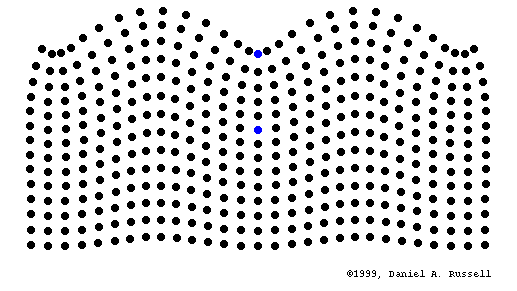Mechanical Waves are waves which propagate through a material medium (solid, liquid, or gas) at a wave speed which depends on the elastic and inertial properties of that medium. There are two basic types of wave motion for mechanical waves: longitudinal waves and transverse waves. The animations below demonstrate both types of wave and illustrate the difference between the motion of the wave and the motion of the particles in the medium through which the wave is travelling.
[The following animations were created using a modifed version of the Mathematica® Notebook " Sound Waves " by Mats Bengtsson.]
Longitudinal Waves
In a longitudinal wave the particle displacement is parallel to the direction of wave propagation. The animation below shows a one-dimensional longitudinal plane wave propagating down a tube. The particles do not move down the tube with the wave; they simply oscillate back and forth about their individual equilibrium positions. Pick a single particle and watch its motion. The wave is seen as the motion of the compressed region (ie, it is a pressure wave), which moves from left to right.

Transverse Waves
In a transverse wave the particle displacement is perpendicular to the direction of wave propagation. The animation below shows a one-dimensional transverse plane wave propagating from left to right. The particles do not move along with the wave; they simply oscillate up and down about their individual equilibrium positions as the wave passes by. Pick a single particle and watch its motion.

Water Waves
Water waves are an example of waves that involve a combination of both longitudinal and transverse motions. As a wave travels through the waver, the particles travel in clockwise circles. The radius of the circles decreases as the depth into the water increases. The movie below shows a water wave travelling from left to right in a region where the depth of the water is greater than the wavelength of the waves. I have identified two particles in blue to show that each particle indeed travels in a clockwise circle as the wave passes.

Rayleigh surface waves
[The following animation was produced with a Mathematica notebook, Rayleigh.ma, which I created to investigate the behavior of Rayleigh waves which occur in solids. This Mathematica notebook contains several other graphs which further analyzer the behavior of Rayleigh waves.]
Another example of waves with both longitudinal and transverse motion may be found in solids as Rayleigh surface waves. The particles in a solid, through which a Rayleigh surface wave passes, move in elliptical paths, with the major axis of the ellipse perpendicular to the surface of the solid. As the depth into the solid increases the "width" of the elliptical path decreases. Rayleigh waves are different from water waves in one important way. In a water wave all particles travel in clockwise circles. However, in a Rayleigh surface wave, particles at the surface trace out a counter-clockwise ellipse, while particles at a depth of more than 1/5th of a wavelength trace out clockwise ellispes. The movie below shows a Rayleigh wave travelling from left to right along the surface of a solid. I have identified two particles in blue to illustrate the counterclockwise-clockwise motion as a function of depth.

(From Acoustics and Vibration Animations - Dan Russell, Kettering University)
|